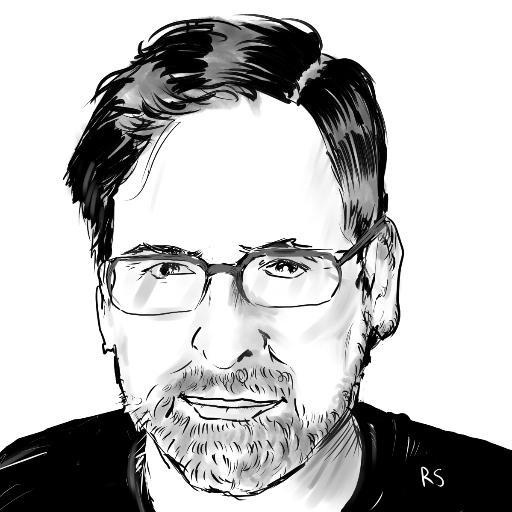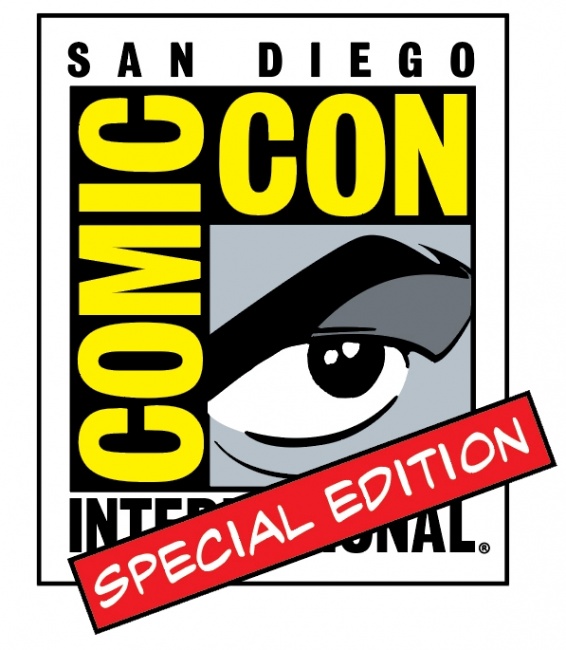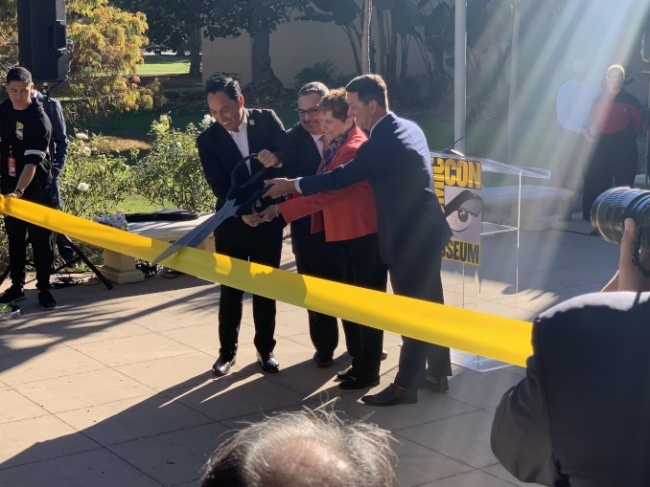A few years ago, I remember reading a statistic that something like 85% of people who worked at Disney World reported having recurring dreams of having the park to themselves. Just imagine: the “happiest place on earth”, minus the crushing crowds, lines and hassles. If that’s been your dream about San Diego Comic-Con, this weekend’s “Special Edition” show was as close as you’re likely to come in the 21st century.
It’s not that the show was empty. Organizers had hoped for 40-50,000 attendees and it felt like they got close to that, especially at peak times on Saturday. They probably could have gotten more if they’d opted to sell one-day tickets instead of sticking exclusively to full-show badges at $150, but, as SDCC candidly acknowledged at the traditional Talkback panel, the organization needed the money.
Comic-Con Unplugged. The event made the crowd feel larger by making everything else a little smaller. The Exhibit Hall only extended to Hall E, about a 30% reduction in space, and most of Hall A was devoted to a holding area for the line for the Funko booth at that end of the floor. Though the hall was marked out with the iconic aisle number banners, the aisles themselves were much wider and the booths spaced out into clumps and islands. There was the usual small press area toward the back of the hall, a grouping of old comic dealers at the front of Halls B and C, a few publishers (Aftershock, Z2, Top Cow, Scout and a couple of others) in the middle, and artist alley at the far end. But most of the traditional landmarks were missing, casualties of the unfortunate Thanksgiving weekend timing, travel restrictions, pandemic concerns, and uncertainty about the importance of being at Special Edition.
SDCC’s programming schedule was more extensive than the larger NYCC show earlier in the fall, but panels were mostly centered on conversations about pop culture topics rather than anything that portended big entertainment or publishing news. As a result, even smaller panels drew bigger-than-expected crowds. With no Hall H, Indigo Ballroom, or even Ballroom 20 to siphon off large numbers of attendees, almost everyone spent most of their time in the exhibit hall.
“Reminded me of a show from the 1990s.” This redounded to the benefit of dealers who took a flier on the show. I spoke to a variety of folks around the hall on Sunday and almost everyone met or exceeded their expectations. One vintage comics dealer who brought an extensive inventory to stock a megabooth down toward artist alley reported having a huge sales weekend, much bigger than NYCC despite the much smaller attendance. Why? No competition. If you wanted to buy old comics, you only had a few choices, and even fewer for original art.
Several toys and collectibles dealers said the show was worth the trouble, especially after having few recent opportunities to sell to in-person crowds. Artists, especially old timers, were happy to not have to share the SDCC spotlight with Hollywood this year, often remarking that this was a throwback to the kind of shows they enjoyed in 1990s. While a lot of people acknowledged the show felt “weird” without all the hoopla, everyone seemed to be having a good time in gloriously sunny San Diego. Most pros savored the chance to dine and drink with friends without the din of massive events and industry parties crowding the social schedule in the evenings.
Do or Die for CCI. Comic-Con International had two big objectives for the event: first to flex their showrunning muscles after a long layoff ahead of WonderCon and SDCC in 2022, and second, to bring much-needed funds into the organization. That last part is especially worrisome in that shows are the only way that the non-profit can bring in revenues to pay the bills. The traditionally frugal organization had plenty of money socked away in a “rainy day fund” but no one expected it to rain for two solid years.
The timing didn’t help SDCC either. Whereas C2E2, for example, was uniquely positioned to hold shows in (early) 2020 and (late) 2021, CCI missed two Wonder Cons and two SDCCs, just after having made a huge investment in the new Comic-Con Museum. CCI’s Chief Marketing and Strategy Officer David Glanzer was quite frank about this in interviews I ran here at ICv2 (see “To Go or Not to Go: An Industry Pro’s Guide to SDCC FOMO“) and Forbes, and at the traditional talkback panel at the conclusion of the Con on Sunday.
SDCC Museum on Display. Speaking of the Museum, it had its gala ribbon cutting on Friday morning, with San Diego’s mayor and several other grandees in attendance, and was open with a few new exhibits as a separately-ticketed attraction. I heard many people express a desire to check it out during the weekend, but I don’t know of anyone, myself included, who actually made it.
The Museum poses both an opportunity and a challenge for CCI. It’s obviously an enormous sunk cost at an inopportune moment. At the same time, a full-time museum operating under the mighty SDCC brand could be a commercial powerhouse, attracting large scale traveling exhibits and becoming a magnet for grants. If run like a business, it could generate recurring revenue in between big shows to stabilizing CCI’s finances. However, taking this approach could run against the grain of CCI’s non-profit, mission-driven instincts, and organizers could decide the venture isn’t worth the trouble if it’s not sustainable on their preferred terms.
Either way, it’s a high stakes decision. The waters for Comic-Con were getting more treacherous even before the pandemic hit, with big entertainment brands like Disney and WarnerMedia obviously itching to supplant the convention with their own branded events and experiences where they could set the agenda and control the media environment, and for-profit pop culture cons from ReedPop and Informa scaling up to Comic-Con-esque size in markets worldwide (see “Looking Forward, Looking Back: SDCC at a Crossroads“).
All’s Well that Ends Well? Special Edition was a reminder to the world that Comic-Con is still here. The Thanksgiving show felt a bit like that episode of Gilligan’s Island where the gang found a cargo plane and had to strip it down to the bare bones to get it in the air. It felt a little shaky at times, and passengers might have missed the amenities of first class, but in the end, it took flight and didn’t crash. The tens of thousands who took advantage of an unusually accessible SDCC experience went home happy; a few professionals and exhibitors got to cleanse their palettes after a bitter year; and we all have something to look forward to again this summer… If all goes well.
The opinions expressed in this column are solely those of the writer(s), and do not necessarily reflect the views of the editorial staff of ICv2.com.
Rob Salkowitz (@robsalk) is the author of Comic-Con and the Business of Pop Culture.
Source: ICv2




